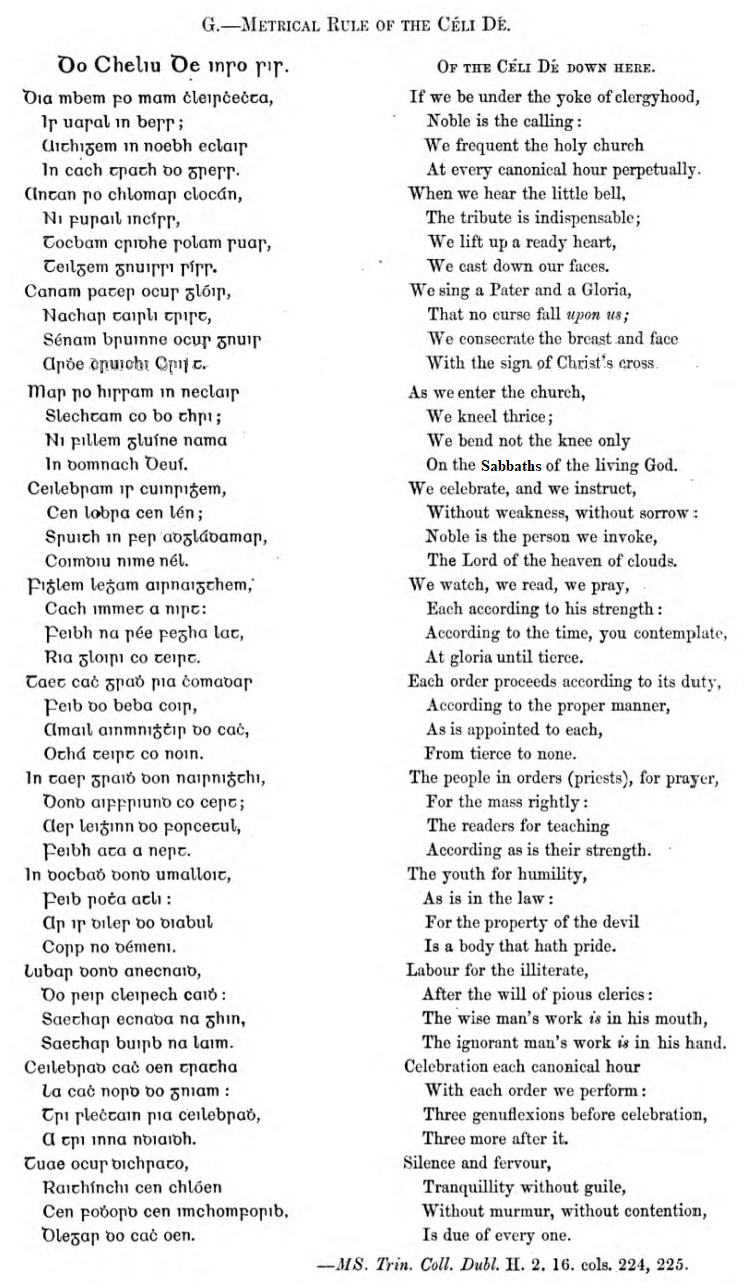The purer ancient Rule of St Maelruan
The rule for the Culdees of Armagh, drawn up by Maelruan, abbot of Tamhlacht (Tallaght), who died in the year 792.

The full chapters of the rule goes into practical usage day to day as well as annual.
This rule has been affirmed by 1600s-1900s historians that it has been used in it’s overriding principles in several of the global institutes of the Culdees. It agrees with standard protestant canonical hours which were part of the Anglican church in the early days as well. All Orthodox. Per the charter of Charles I, in 1627 he recognized the same head of the Priory and twelve students attached to Armagh as long successors of St Patrick as heirs of the original Culdees. However he reduced their number to eight, naming them “the Prior and Vicars Choral” of the cathedral church of Armagh.
Below are some quotes about the Rule of Maelruan. All of it is compliant with the traditions and culture of the Irish who are descended of the House of Judah (Protected by the Red Branch Knights etc). Even the signing with the sign of the cross was done at all Hebrew baptisms. The tau sign being the Biblical of protection from the destroyer, foreshadowing our Savior Jesus Christ (Yahshua). In Hebrew thought this would be a great and most orthodox method of worship, as was the basis of the Celtic church.
Some quotes from Keating’s history, who did not consider the Culdees to be monks because they had wives and children. However much later they regularly confirmed married Abbots (even at the more strictest time well into the 14-1500s / till the time of the Reformation, where the British Israel teacher Bishop Ussher clearly transmitted the Culdees and recognized by the Culdee protector O’Neill Clans in his day as making peace on the point of the Hebrew teachings of the Culdees, including the Hebrew ceremonies advanced by Ussher as fulfillment of types of Christ). A lot of historians do just go with the conventional definition of Monastic, although the Celtic church established earliest Orthodox Western Monasticism with with wives and children. (On Celtic Married Clergy and Monastics),
More on the Orthodox Order of the Culdees from Keating’s history:
Page 33: “The Culdees, who were in the church of Armagh, were not monks, but secular canons, who lived in community, and had their wives and children; and it was they who had the chief authority in the church of Armagh, as we read in the life of St. Bernard.”
• Page 34: “And it is not to be supposed that St. Patrick left any other order in Armagh than that of Culdees, i.e., religious persons who lived according to the order of the canons regular; for it is certain that St. Patrick did not leave any monks in Ireland, as we shall show hereafter.”
• Page 35: “And it is probable that these Culdees were the successors of those whom St. Patrick left in Armagh; and that they were secular canons, who lived according to a certain rule, as was usual in those times.”
• Page 36: “And this is confirmed by an ancient manuscript in the library of Trinity College, Dublin, which contains a rule for the Culdees of Armagh, drawn up by Maelruan, abbot of Tamhlacht (Tallaght), who died in the year 792; which rule prescribes to them certain prayers, fasts, devotions, confession, and penances; but does not enjoin them to make any vows of poverty, chastity, or obedience; nor does it forbid them to have wives or children; nor does it oblige them to live in cloisters or cells; but only to dwell together in one house or college.”
• Page 37: “And this rule was not peculiar to the Culdees of Armagh; but was common to all those who were called Culdees in Ireland; as appears from an ancient manuscript in the Cottonian library, which contains a rule for the Culdees of Devenish (an island in Lough Erne), which is the same with that of Maelruan for the Culdees of Armagh.”
• Page 38: “And from these testimonies it is evident that the Culdees were not monks, but secular canons; and that they were the standing clergy of several churches and cathedrals in Ireland; and that they had no other rule than that of Maelruan, which was very different from any monastic rule.”
• Page 39: “And therefore we may conclude that St. Patrick did not institute any other order in Ireland than that of Culdees or secular canons; and that he did not leave any monks or regular clergy in this island.”
